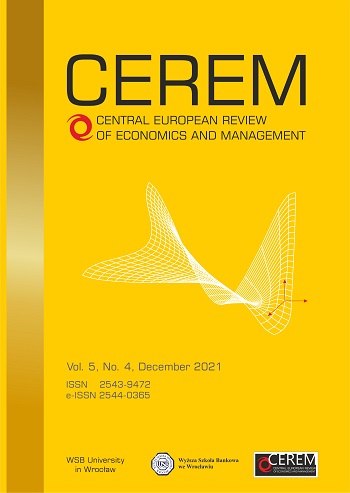Design of a rule based monetary policy in a Central Bank Digital Currency System
DOI:
https://doi.org/10.29015/cerem.928Słowa kluczowe:
Design, CBDC, Rule-based, Monetary policy, Inflation correction, Domestic product proxyAbstrakt
Aim: This paper presupposes a purely Central Bank Digital Currency (CBDC) based system. Its aim is to describe how such a system facilitates complete new possibilities to design a suitable monetary policy. More specifically, the purpose is to show that the available monetary tools can be used to design a rule-based monetary policy that guarantees stability of purchasing power and interest rates.
Research methods: The paper is design oriented. It describes how the monetary system could function The important monetary variables are defined and their relationship is described. To illustrate these variables and their relationship, simulation results of their behavior are added.
Conclusions: It is shown that it is indeed possible to design a monetary policy that is rule based and guarantees stability of purchasing power and interest rates. Crucial elements in the design are linking the balances of the CBDC-accounts to a proxy of the domestic product and replacing the use of government bonds by allowing the government to borrow from the Central Bank and giving households and businesses the opportunity to open a savings account at the Central Bank.
Originality: The approach is completely new. It is the result of rethinking the possibilities of a complete transition of bank money to CBDC.
Implications: The paper shows that a more absolute transition to the use of CBDC makes it possible to establish a clearer and more stable monetary practice, and that it is necessary therefore to revise monetary theory.
Bibliografia
Admati A., Hellwig M. (2013), The Bankers New Clothes, Princeton University Press, New York.
Bordo M.D., Levin A.T. (2017), Central Bank Digital Currency and the Future of Monetary Policy, NBER Working Paper Series 23711.
Buiter W.H. (2009), Negative Nominal Interest Rates. Three Ways to Overcome the Zero Lower Bound, “The North American Journal of Economics and Finance”, vol. 20 no. 3, pp. 213–238.
Dyson B., Hodgson G., Van Lerven F. (2016), A Response to Critiques of ‘Full Reserve Banking’, “Cambridge Journal of Economics”, vol. 40, pp. 1351–1361.
ECB (2020), Report on a Digital Euro,
https://www.ecb.europa.eu/pub/pdf/other/Report_on_a_digital_euro~4d7268b458.en.pdf [01.09.2021].
Fontana G., Sawyer M. (2016), Full Reserve Banking. More ‘Cranks’ than ‘Brave Heretics’, “Cambridge Journal of Economics”, vol. 40 no. 5, pp. 1333–1350.
Friedman M. (1960), A Program for Monetary Stability, Fordham University Press, New York.
Goodhart Ch.A.E., Jensen M.A. (2015), A Commentary on Patrizio Lainà’s ‘Proposals for Full Reserve Banking: A Historical Survey from David Ricardo to Martin Wolf’, “Economic Thought”, vol. 4 no. 20, pp. 20–31.
Van Hee K., Wijngaard J. (2019), All Attention to Debt Stands in the Way of Improving Money, “ESB”, vol. 104, pp. 251–253.
Van Hee K., Wijngaard J. (2021), A new digital currency system, :Central European Review of Economics and Management”, vol. 5 no. 4, pp. 33-60.
Huber J. (2017), Sovereign Money. Beyond Reserve Banking, Palgrave, Cham.
Jackson A., Dyson B. (2012), Modernising Money. Why Our Monetary System Is Broken and How It Can Be Fixed, Positive Money, London.
Kamstra M., Shiller R. (2008), The Case for Trills. Giving Canadians and Their Pension Funds a Stake in the Wealth of the Nation, “C.D. Howe Institute Commentary”, no. 271, https://www.cdhowe.org/sites/default/files/attachments/research_papers/mixed//commentary_271.pdf [01.09.2021].
Kelton S. (2020), The Deficit Myth. Modern Monetary Theory and How to Build a Better Economy, John Murray, London.
Levin A. (2014), The Design and Communication of Systematic Monetary Policy Strategies, “Journal of Economic Dynamics and Control”, vol. 49(C), pp. 52–69.
Piketty T. (2014), Capital in the Twenty-First Century, Harvard University Press, Cambridge MA.
Roubini N., Mihm S. (2010), Crisis Economics. A Crash Course in the Future of Finance, Penguin Books, London.
Ryan-Collins J., Greenham T., Werner R., Jackson A. (2011), Where Does Money Come from, New Economics Foundation, London.
Stokey N.L. (2002), ‘Rules vs Discretion’ after Twenty-Five Years, “NBER Macroeconomics Annual”, vol. 17.
Sveriges Riksbank (2017), The Riksbank’s e-krona project: Report 1, https://www.riksbank.se/globalassets/media/rapporter/e-krona/2017/rapport_ekrona_uppdaterad_170920_eng.pdf [01.09.2021].
Taylor J.B. (1993), Discretion versus Policy Rules in Practice, “Carnegie-Rochester Conference Series on Public Policy”, vol. 39, pp. 195–214.
Pobrania
Opublikowane
Numer
Dział
Licencja
Autor przenosi nieodpłatnie na Wyższą Szkołę Bankową we Wrocławiu , bez ograniczeń terytorialnych, majątkowe prawa autorskie do tego utworu w rozumieniu ustawy z dnia 4 lutego 1994 roku o prawie autorskim i prawach pokrewnych ( Dz.U. 1994, Nr 24, poz. 83 ze zm. )na zasadzie wyłączności, tj. prawo do:
a) wyłącznego używania i wykorzystania utworu w dowolnej działalności przez Wyższą Szkołę Bankową we Wrocławiu, w szczególności w działalność Biblioteki Cyfrowej uruchomionej przez Wyższą Szkołę Bankową we Wrocławiu
b) wytwarzania, utrwalania i zwielokrotniania egzemplarzy utworów wszelkimi technikami, w tym techniką drukarską, reprograficzną, zapisu magnetycznego oraz techniką cyfrową, w szczególności ich zwielokrotniania poprzez dokonywanie zapisów na płytach typu CD,
c) zamieszczenia wybranych fragmentów utworu w celach promocyjnych w publikacjach, materiałach promocyjnych, w sieci Internet oraz sieciach wewnętrznych typu Intranet Wyższej Szkoły Bankowej we Wrocławiu,
d) wprowadzania utworu do pamięci komputera Wyższej Szkoły Bankowej we Wrocławiu,
e) kopiowania i powielania utworu w technologiach fotomechanicznych lub innych znanych w dniu zawarcia umowy (fotokopie, kserokopie itp.),
f) przetworzenia dzieła na formę elektroniczną i nieograniczonego rozpowszechniania w sieci Internet.


